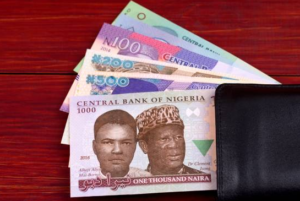Barely four days after the redesigned new naira notes were unveiled by the Central Bank of Nigeria (CBN), fake notes have already emerged and are in circulation.
Displaying the original and the fake currencies, a man declared that his wife who runs a PoS machine business was paid with fake N1,000 new naira notes
He said: “Ladies and gentlemen. Fake money is in town now. People should be very careful. This is the original one, while this is the fake one.

“My wife is doing PoS business, someone gave her this money, but we do not know who it was. We later discovered that the money is fake.”
The motive behind the redesigned currency was to mop up the excess cash outside the banking system while taming inflation and counterfeiting currency in circulation.
Central Bank Governor Godwin Emefiele, had also explained that the introduction of new notes was a deliberate step by the government to check corruption and counterfeiting of the notes.
The Central Bank of Nigeria according to the CBN Act (Sections 17, 18, and 19) is responsible for the issuance of the Naira and Kobo
It is also against the law for any individual or establishment outside the CBN, to print money or have counterfeit notes.
“If you are caught and convicted of a counterfeiting crime, you may face up to five (5) years imprisonment with no option of fine (Section 20),” the CBN said in a circular on its website.
The CBN said the Naira banknotes are protected by several security features to enable the easy recognition of genuine notes.
The distinguishing features which can be recognized by touch and visibility are the raised print, the security thread, and the watermark.
Other areas such as the portrait, lettering, and the denominational numerals on the obverse and reverse of the notes are embossed.
“The raised prints provide the tactility, while the security thread, which ordinarily, looks broken but is not when held up against the light, has “CBN” in small lettering printed on both sides of the notes.
“The Naira notes are also protected against photocopying. There are also features visible under ultraviolet light; for example, the serial number on each banknote is black, but turns green under ultraviolet light,” the apex bank said in a note on its website.
The CBN’s Banknote Fitness Standards also provide the general public with clear, acceptance criteria for determining the quality of banknotes in circulation.
It shows the stages of degradation by soiling, and limpness and thus defines the acceptable threshold for fit notes in circulation.
The fitness criteria include the durability and functionality of security features on the notes, banknotes structure and durability, and banknote quality i.e. print and appearance of notes.
The Clean Note Policy was instituted by the CBN in a bid to improve the physical appearance and lifespan of the banknotes in circulation.
The concept of the Clean Note Policy requires that the production, issuance of new banknotes, and recirculation by the DMBs/CPCs must conform to the predetermined standards.

It also aims at ensuring that the quality of Naira banknotes in circulation must be in good condition to allow for processing and free acceptability by the general public.
“The document displays features on the obverse and reverse of the banknotes. It also states the responsibilities for issuance, recirculation and processing, counterfeits and mutilated notes management, and standards for banknotes processing machines.
“The public awareness campaign on Naira abuse and handling are also highlighted to aid the longevity of the banknotes and reduce the huge cost of processing and banknote replacement,” the CBN said.

